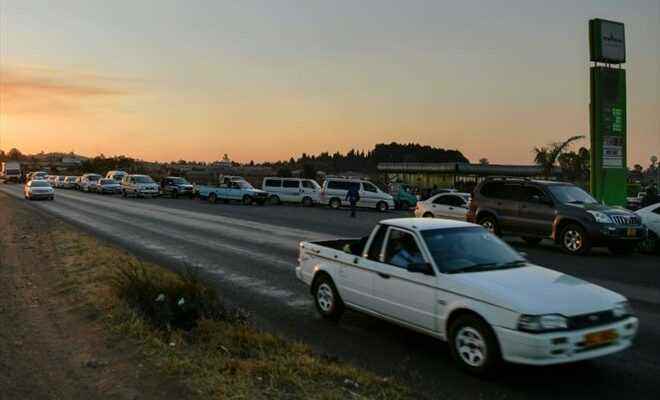At a gas station in Harare, January 11, 2019 (AFP/Archives/Jekesai NJIKIZANA)
Hyperinflation is attacking incomes in Zimbabwe. Emina Chishangwe can’t remember when she last ate meat. “It’s become a luxury,” says the 57-year-old woman who runs a small vegetable stall near Harare.
The Southern African country has the highest inflation rate in the world. And for Steve Hanke, professor of economics at the American University Johns Hopkins, this can only be corrected by the total adoption of the American dollar.
The situation has worsened this year. Russia’s invasion of Ukraine, combined with the currency black market, caused the value of the Zimbabwean dollar to plummet.
“The parallel market is largely responsible for runaway inflation,” Joseph Mverecha, chief economist at AgriBank, told AFP.
The country’s economy has been weighed down for twenty years, marked by shortages of money and food. Suspicious people swapped their cash for US dollars, causing the local currency to plummet further.
Inflation reached 191.6% in June, compared to 60% at the start of the year.
Five kilos of chicken drumsticks are now worth 65.22 dollars (64 euros), equivalent to the average monthly salary of a civil servant.
Ms. Chishangwe and her two adult sons, who live in Chitungwiza, a poor dormitory town south of the capital, eat two meals a day instead of three, based on thick maize porridge and kale or tiny dried sardines.
– Anxiety –

Queue outside a Harare supermarket on January 16, 2019, after a strike against the government’s fuel price hike (AFP/Archives/Jekesai NJIKIZANA)
The price of fuel forced Edwin Matsvai to switch from a 4×4 to a more economical model. His friends laughed, “but now some are considering doing the same,” says this salesman at a dealership.
A liter of gasoline went from $1.41 in January to $1.77 this month.
Zimbabweans survived the worst difficulties in 2008 when, in the face of inflation, the central bank had to issue a trillion local dollar note.
For psychiatrist Isabel Chinoperekwei, who has a private practice in Harare, the growing gap between income and cost of living has repercussions: “I see a lot of people who are overwhelmed by this context, between depression, anxiety disorders and alcohol abuse “.
Many blame the government. “The old people let us down,” says Edwin Matsvai. “If they don’t do something quickly for the economy, it will cost them dearly” in the elections scheduled for next year.
Already, during partial legislative elections in March, the ruling Zanu-PF party lost ground to the Citizens’ Coalition for Change (CCC), an opposition party formed three months earlier.
– Lost confidence –

Long queue outside a petrol station in Harare on September 10, 2019 (AFP/Archives/TONY KARUMBA)
According to several experts, the current landscape bears a resemblance to the crisis that preceded the 2008 elections, during which former leader Robert Mugabe nearly lost power.
“People earning poverty wages, the unemployed and all those feeling the effects of the rising cost of living have lost faith in Zanu-PF,” said Takavafira Zhou, a political scientist at Masvingo University. They hope for “a new government that would allow them to breathe”.
Zanu-PF has been in power since 1980, when British colonial rule ended. Current President Emmerson Mnangagwa took over from Mugabe in a 2017 coup, pledging to fix the moribund economy.
The electoral risk is now pushing Zanu-PF to “frenzied measures” to curb the rise in prices which is further impoverishing millions of people, says economist Prosper Chitambara.
“There is not a ruling party in the world that is doing well in an environment of chronic high inflation,” notes the researcher.
Last month, Finance Minister Mthuli Ncube announced monetary measures, including maintaining the dual use of the US dollar, adopted after the 2008 hyperinflation, and the Zimbabwean dollar, reintroduced in 2019.
Minimum interest rates more than doubled to 200% last week. The country is also introducing gold coins “as a store of value” from July 25.
But these measures concern the rich, not “ordinary citizens, those who struggle and live from day to day”, notes the economist.
© 2022 AFP
Did you like this article ? Share it with your friends with the buttons below.




